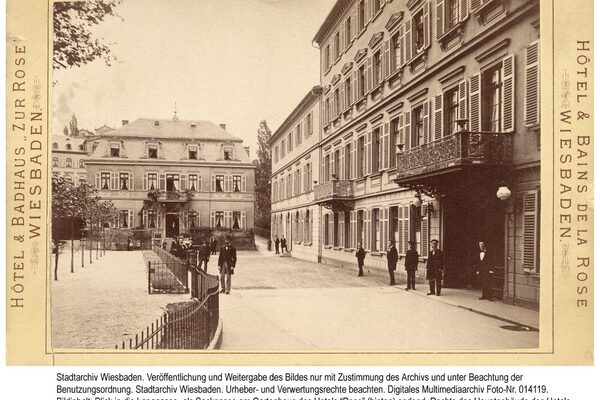Hotel Rose
The Hotel Rose on the south-east side of Kochbrunnenplatz can be traced back to 1500. At the end of the 18th century, the inn and bathhouse with its farm buildings, gardens and garden house extended as far as the later Taunusstrasse. In 1828, the Rose was one of the four largest and most distinguished bathhouses and inns in Wiesbaden.
In 1859, the Hotel Rose came into the possession of the August Alten and Heinrich Haeffner families; the latter ran the hotel until the end of the Second World War. In 1872/73, the brothers Gustav and Heinrich Haeffner had a prestigious four-storey new building, the so-called Neue Rose, erected in place of the front building on Kranzplatz and sold the entire complex to the city in 1886, which in turn appointed the brothers as leaseholders.
From 1893, the plan to build a grand hotel matured. Between 1896 and 1904, first the north-eastern section was completed according to plans by architect Wilhelm Kaufmann and then the south-western section according to plans by architects Lang & Wolff. The new building, whose sandstone façade was designed in the neo-baroque style, had around 200 rooms and suites in the style of Louis XVI and offered every comfort with a dining room, lounges, a garden, terraces, a thermal swimming pool with a direct inflow from the Kochbrunnen, an indoor tennis court and much more.
The slow decline began after the First World War. In 1926, the rooms on the first floor were rented out as stores. Only slightly damaged during the Second World War, the hotel was confiscated by the Americans in 1945 and returned to Adalbert Rosenow, a nephew of the previous owners, in 1958 and reopened in March 1959 after renovation and refurbishment. Hotel operations ended in 1989.
In 1991, building contractor and speculator Jürgen Schneider acquired the building with the intention of opening a luxury hotel here. In the course of the renovation, a large part of the historic building fabric as well as the original room layout and interior design were lost. Following Schneider's bankruptcy in 1994 and years of vacancy, the former Hotel Rose came into the possession of the state of Hesse in 2001 and, following extensive renovation and restoration, has housed the State Chancellery and the Hessian State Center for Political Education since 2004.
Literature
Baumgart-Buttersack, Gretel: From the old "Badhaus zur Rose" to the international Grand Hotel. In: Wiesbadener Leben 4/1992 [pp. 25-27].
Czysz, Walter: Vom Römerbad zur Weltkurstadt, Geschichte der Wiesbadener heißen Quellen und Bäder, Wiesbaden 2000 (Schriften des Stadtarchivs Wiesbaden 7) [p. 54; 303 f. 323 f.].
From the Hotel Rose to the new State Chancellery. OFB Projektentwicklungs-GmbH (ed.), Frankfurt 2004.
